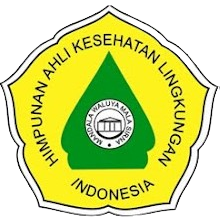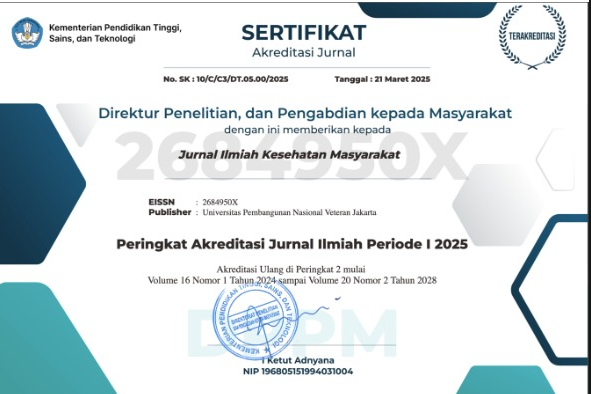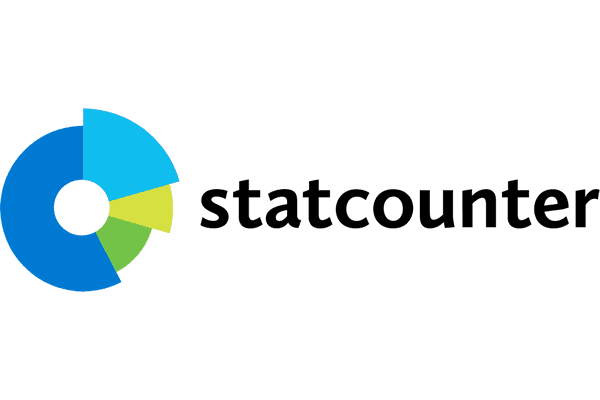Model Spasial Faktor Risiko Tuberkulosis di Provinsi Jawa Barat Tahun 2021: Pemanfaatan Data Rutin untuk Pengambilan Keputusan
Abstract
Latar Belakang: Pemanfaatan data rutin di bidang kesehatan salah satunya untuk mengestimasi beban suatu penyakit termasuk determinannya. Tuberculosis (TB) masih menjadi masalah kesehatan global yang menginfeksi 10,6 juta orang di seluruh dunia pada tahun 2021, dimana Indonesia menjadi penyumbang beban kasus tertinggi kedua. Jawa Barat merupakan provinsi dengan jumlah temuan kasus TB terbanyak di Indonesia dalam 5 tahun terakhir
Metode: Data bersumber dari Badan Pusat Statistik (BPS) Provinsi Jawa Barat tahun 2022 dan Statistik Perumahan Provinsi Jawa Barat 2021. Analisis deskriptif, autokorelasi spasial, dan analisis Geographically Weighted Regression (GWR) dilakukan menggunakan perangkat lunak pengolahan data, GeoDa dan GWR4. Hasil disajikan dalam bentuk peta menggunakan aplikasi QGIS. Analisis spasial dilakukan untuk melihat persentase kasus TB dengan faktor-faktor risiko TB.
Hasil: Hasil dari penelitian ini menunjukkan adanya autokorelasi spasial positif yang berpengaruh signifikan terhadap jumlah kasus TB di Provinsi Jawa Barat yang artinya sebaran kasus membentuk pola mengelompok. Adapun kabupaten/kota yang menjadi hotspot dan merupakan wilayah prioritas intervensi penanganan kasus TB di Provinsi Jawa Barat adalah Kabupaten Bekasi, Kabupaten Bogor, Kabupaten Karawang, Kabupaten Purwakarta, Kabupaten Sukabumi, Kota Bekasi, Kota Bogor dan Kota Depok. Model GWR menemukan faktor risiko yang memiliki pengaruh berbeda di tiap wilayah kabupaten/kota yaitu penduduk miskin, suhu dan ketinggian wilayah, sehingga bentuk intervensi kesehatan yang dilakukan juga berbeda.
Kesimpulan: Pemanfaatan data rutin dengan pendekatan spasial ini diharapkan dapat menjadi pendukung pengambilan keputusan (decision making support) terkait program dan kebijakan intervensi kesehatan yang spesifik wilayah sehingga tepat sasaran dan mampu menurunkan jumlah kasus TB.
Kata kunci: Analisis spasial, Faktor risiko, GWR, Pemanfaatan data rutin, Tuberkulosis
Background: One of the uses of routine data in the health sector is to estimate the burden of a disease including its determinants. TB remains a global health problem that infected 10.6 million people worldwide in 2021, and Indonesia has the second highest TB caseload globally. West Java is the province with the highest number of TB case findings in Indonesia in the last five years.
Method: Data sourced from 2022 West Java Province Central Statistics Agency and 2021 West Java Province Housing Statistics. Descriptive analysis, spatial autocorrelation, and GWR analysis were carried out using SPSS, GeoDa, and GWR4. Results were presented in map form using QGIS application. Spatial analysis was carried out to know the percentage of TB cases with TB risk factors.
Result: The results of this study indicate a positive spatial autocorrelation that has a significant effect on the number of TB cases in West Java, which means that the distribution of cases forms a clustered pattern. The regencies/cities that have become hotspots and priority areas for intervention in handling TB cases in West Java were Bekasi Regency, Bogor Regency, Karawang Regency, Purwakarta Regency, Sukabumi Regency, Bekasi City, Bogor City and Depok City. The GWR model found risk factors that have different effects in each regency/city area, specifically the poor population, temperature, and altitude so the forms of health interventions carried out were also different.
Conclusion: The utilization of routine data with a spatial approach is expected to be decision-making support related to region-specific health intervention programs and policies so that they are targeted and able to reduce the number of TB cases.
Keywords: GWR, Risk factor, Routine data utilization, Spatial analysis, Tuberculosis
References
Pujosiswanto KH, Palutturi S, Ishak H. Faktor-Faktor Yang Mempengaruhi Implementasi Program Indonesia Sehat dengan Pendekatan Keluarga (PIS-PK) di Puskesmas Kabupaten Polewali Mandar. Jurnal Kesehatan Masyarakat Maritim. 2020;3(1).
Dash S, Shakyawar SK, Sharma M, Kaushik S. Big data in healthcare: management, analysis and future prospects. Journal of Big Data [Internet]. 2019;6(54). Tersedia pada: https://doi.org/10.1186/s40537-019-0217-0.
WHO. Data collection and analysis tools [Internet]. [cited 2023 Jun 9]. Available from: https://www.who.int/data/data-collection-tools.
WHO. Tuberculosis [Internet]. 2022 [cited 2023 Jan 24]. Available from: https://www.who.int/news-room/fact-sheets/detail/tuberculosis.
WHO. Global Tuberculosis Report 2022. Geneva; 2022.
Kementerian Kesehatan. Profil Kesehatan Indonesia 2021. 2022.
Achmadi UF. Manajemen Penyakit Berbasis Wilayah. Ed. Revisi, Cet, 2. Jakarta: PT RajaGrafindo Persada; 2014.
Achmadi UF. Manajemen Penyakit Berbasis Wilayah. Kesmas: Jurnal Kesehatan Masyarakat Nasional. 2009;3(4):147–53.
Castro RR, Santos RSC, Sousa GJB, Pinheiro YT, Martins RRIM, Pereira MLD, et al. Spatial dynamics of the COVID-19 pandemic in Brazil. Epidemiology and Infection. 2021 Feb;149(60):1–9.
Mergenthaler C, Gurp M, Rood E, Bakker M. The study of spatial autocorrelation for infectious disease epidemiology decision-making: a systematized literature review. CABI Reviews. 2022 Jul 15;2022.
Biermann O, Mwoka M, Ettman CK, Abdalla SM, Shawky S, Ambuko J, et al. Data, Social Determinants, and Better Decision-making for Health: the 3-D Commission. Journal of Urban Health. 2021 Aug 1;98:4–14.
Eryando T. Spatial Analysis for Enhancing the Use of Health Data Availability from Different Sources to Help the Decision-Making Process. Kesmas: Jurnal Kesehatan Masyarakat Nasional. 2022 Aug 1;17(3):165–8.
Pradana KA, Santosa PB. Spatial Autocorrelation Analysis of Tuberculosis Cases (2016-2018) In Kebumen. KnE Engineering. 2019 Dec 19.
Rajak SS, Ismail S, Resmawan R. Metode Conditional Autoregressive dalam Analisis Penyebaran Kasus Penyakit Tuberculosis. Jambura Journal of Probability and Statistics. 2021 Apr 15;2(1):28–34.
Gwitira I, Karumazondo N, Shekede MD,
Sandy C, Siziba N, Chirenda J. Spatial patterns of pulmonary tuberculosis (TB) cases in Zimbabwe from 2015 to 2018. Vol. 16, PLoS ONE. Public Library of Science; 2021.
Sakti ES, Makful MR, Dewi R. Analisis Spasial Prioritas Penanganan Stunting Di Provinsi Aceh Tahun 2021. J Mutiara Kesehat Masy. 2023;8(1):10–23.
Sipahutar T. Pemodelan Determinan Kejadian Stunting untuk Percepatan Pencegahan Stunting di Indonesia: Analisis Spasial. [Depok]: Universitas Indonesia; 2020.
Rani RN, Rameshwari TKR, Kumar S. Detection of tuberculosis hotspots using spatial interpolation method in Mysuru District, Karnataka. Journal of Applied Biology and Biotechnology. 2021;9(2):124–30.
Dowdy DW, Golub JE, Chaisson RE, Saraceni V. Heterogeneity in tuberculosis transmission and the role of geographic hotspots in propagating epidemics. Proceedings of the National Academy of Science USA. 2012 Jun 12;109(24):9557–62.
Hernawan AD, Erlina L, Biatmojo BA. Intervensi TB-Paru Melalui Edukasi dan Konseling di Desa Pasir Panjang Wilayah Binaan Puskesmas Antibar Kabupaten Mempawah. Buletin Al-Ribaath. 2019;16:65–8.
Khariyani AM, Kismiantini K, Setiawan EP. Analisis Faktor-Faktor yang Memengaruhi Jumlah Penderita Tuberkulosis Menggunakan Geographically Weighted Regression di Provinsi Jawa Timur. Prosiding Seminar Nasional Matematika, Statistika, dan Aplikasinya. 2022 May.
Sihaloho ED, Amru DS, Agustina NI, Tambak HSP. Pengaruh Angka Kemiskinan Terhadap Angka Tuberkulosis di Indonesia. Journal of Applied Business and Economics (JABE). 2021 Mar;7(3):325–37.
Oxlade O, Murray M. Tuberculosis and Poverty: Why Are the Poor at Greater Risk in India? PLoS One. 2012 Nov 19;7(11).
WHO. Diabetes [Internet]. 2022 [cited 2023 Jan 16]. Available from: https://www.who.int/news-room/fact-sheets/detail/diabetes.
Saputra FF, Wahjuni CU, Isfandiari MA. Spatial Modeling of Environmental-Based Risk Factors of Tuberculosis in Bali Province: An Ecological Study. Jurnal Berkala Epidemiologi. 2020 Jan 28;8(1):26.
Lima SVMA, Rocha JVM, de Araújo KCGM, Nunes MAP, Nunes C. Determinants associated with areas with higher tuberculosis mortality rates: an ecological study. Tropical Medicine and International Health. 2020 Mar 1;25(3):338–45.
Pathak D, Vasishtha G, Mohanty SK. Association of multidimensional poverty and tuberculosis in India. BMC Public Health. 2021 Dec 1;21(1).
Jabir RA, Rukmana A, Saleh I, Kurniawati T. The Existence of Mycobacterium tuberculosis in Microenvironment of Bone. InTech. 2017.
BPS Provinsi Jawa Barat. Provinsi Jawa Barat Dalam Angka 2022. BPS Provinsi Jawa Barat, editor. BPS Provinsi Jawa Barat; 2022.
Pakaya R, Olii MR, Djafar L. Spatial Distribution of Smear Positive Pulmonary Tuberculosis Correlated with Weather Factors in Gorontalo City 2016-2018. Gorontalo Journal of Public Health. 2021;4(1):1–12.
Xu M, Li Y, Liu B, Chen R, Sheng L, Yan S, et al. Temperature and humidity associated with increases in tuberculosis notifications: a time-series study in Hong Kong. Epidemiology Infection. 2020 Dec 28;149:e8.
Azhari AR, Kusumayati A, Hermawati E. Studi Faktor Iklim dan Kasus TB di Kabupaten Serang, Provinsi Banten. HIGEIA: Journal of Public Health Research and Development [Internet]. 2022;6(1):93–105. Available from: http://journal.unnes.ac.id/sju/index.php/higeia.
Gelaw YA, Yu W, Magalhães RJS, Assefa Y, Williams G. Effect of temperature and altitude difference on tuberculosis notification: A systematic review. Journal of Global Infectious Diseases. 2019;11(2):63.
Siwiendrayanti A, Sukendra DM, Arofah D. Analisis Spasial dan Temporal Persebaran Kasus Baru TB Paru BTA (+) di Kabupaten Batang. J Kesehat Lingkung Indones. 2018;17(2):95.
Situmeang WY, Pinandhika, Sumampow M, Chain V, Lestari P, Hariyati RTS, et al. Studi Kasus: Perencanaan Strategis Sistem Informasi Manajemen Keperawatan Di Rumah Sakit Wilayah Kota Depok. Indones J Nurs Sci. 2023;3(1):16–21.
Theron G, Jenkins HE, Cobelens F, Abubakar I, Khan AJ, Cohen T, et al. Data
for action: Collection and use of local data to end tuberculosis. Vol. 386, The Lancet.
Lancet Publishing Group; 2015. p. 2324–33
Hung YW, Hoxha K, Irwin BR, Law MR, Grépin KA. Using routine health information data for research in low- And middle-income countries: A systematic review. Vol. 20, BMC Health Services Research. BioMed Central; 2020.









.jpg)








